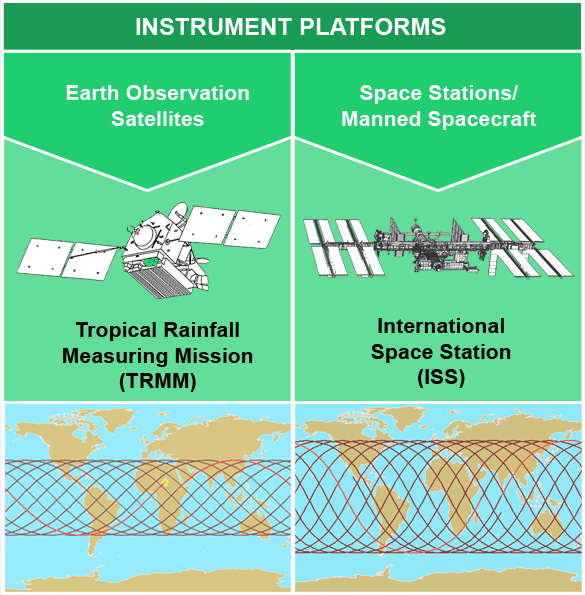Earth Observations: Lightning Imaging Sensor (LIS)
The Lightning Imaging Sensor (LIS) detects total lightning (i.e. cloud-to-cloud, cloud-to-ground, and intra-cloud flashes) from a space-based platform.
The LIS is based on digital imaging technology and built around a 128 x 128 charged coupled device (CCD) array that is used to extract only the optical emissions of lightning through Earth's atmosphere for both day and night backgrounds.
Distribution and variability of total lightning. Amount, rate, and radiant energy of total lightning during both day and night.

| SPATIAL RESOLUTION | SPATIAL EXTENT | SWATH WIDTH | ACCURACY | WAVELENGTH | SAMPLING DURATION |
|---|---|---|---|---|---|
|
TRMM LIS: 4 km ISS LIS: 4 - 8 km |
TRMM LIS: 38 N - 38 S ISS LIS: 55 N - 55 S |
Field of View 80 x 80 |
Detection efficiency ranges from 69% near noon to 88% at night |
777.4 nm | approx. 90 s |
Boccippio, Dennis J., William J. Koshak, and Richard J. Blakeslee. "Performance assessment of the Optical Transient Detector and Lightning Imaging Sensor. Part I: Predicted Diurnal Variability." Journal of Atmospheric & Oceanic Technology 19.2 (2002): 1318.
Mach, Douglas M., Hugh J. Christian, Richard J. Blakeslee, Dennis J. Boccipio, Steven J. Goodman, and William L. Boeck. "Performance assessment of the Optical Transient Detector and Lightning Imaging Sensor." Journal of Geophysical Research 112 (2007): D09210, doi:10.1029/2006JD007787.
LIS Algorithm Theoretical Basis Document (ATDB): https://ghrc.nsstc.nasa.gov/pub/preservation/LIS/atbd-lis-2000.pdf















